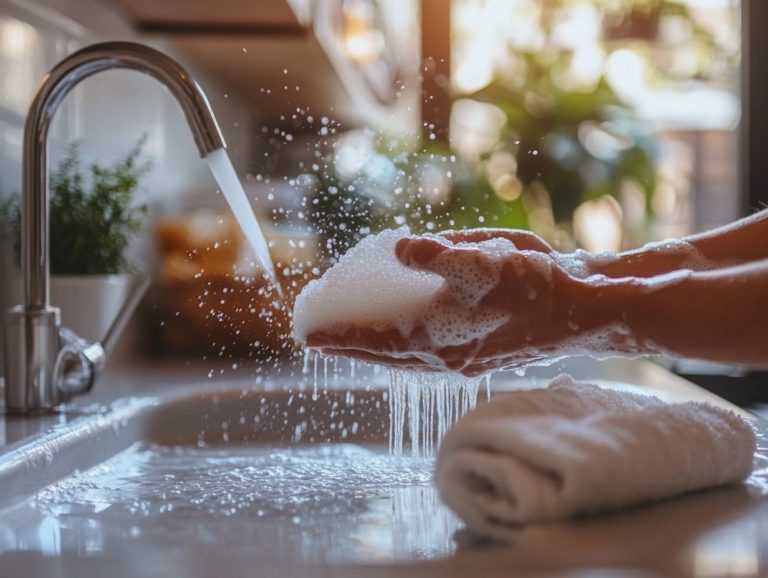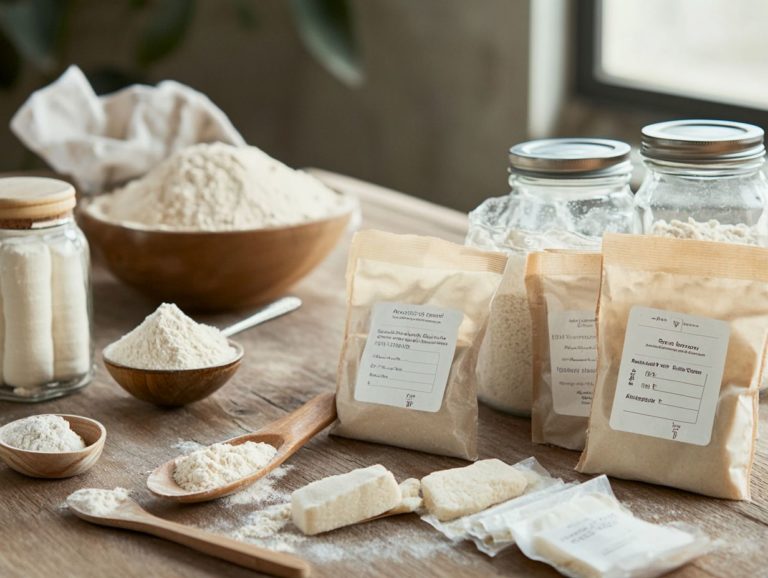Is Home Brewing Suitable for Beginners?
Home brewing is a rewarding and creative hobby that empowers you to craft your own beer right in the comfort of your home. Whether you re a curious beginner or a seasoned expert, there s an undeniable charm in brewing a unique batch that reflects your personal taste. This guide will walk you through the essentials of home brewing, covering everything from its many benefits and the equipment you’ll need to the diverse styles of beer you can create, such as brewing soda and how to troubleshoot common issues. By the end, you ll feel fully prepared and confident to embark on your brewing journey! Let s dive into the world of home brewing together!
Contents
- Key Takeaways:
- What is Home Brewing?
- Why Should Beginners Consider Home Brewing?
- What Are the Basic Equipment and Ingredients Needed for Home Brewing?
- What Are the Essential Ingredients for Home Brewing?
- How to Get Started with Home Brewing?
- What Are the Steps to Make Home Brew?
- What Are the Different Types of Beer That Can Be Brewed at Home?
- Is Home Brewing Safe for Beginners?
- What Are the Safety Precautions to Follow When Home Brewing?
- How to Troubleshoot Common Issues in Home Brewing?
- Frequently Asked Questions
- Is Home Brewing Suitable for Beginners?
- What equipment do I need to start home brewing?
- Do I need any special skills or knowledge to start home brewing?
- Are there any resources available to help beginners with home brewing?
- Is home brewing cost-effective for beginners?
- Are there any safety concerns with home brewing for beginners?
Key Takeaways:

- Home brewing is a great hobby for beginners, offering a variety of benefits such as cost savings, creativity, and quality control.
- To get started, beginners will need basic equipment such as a fermenter, fermentation air lock, and ingredients like malt, hops, and yeast.
- Safety precautions and troubleshooting knowledge are important for beginners to ensure a safe and successful home brewing experience, including how to clean and sanitize equipment.
What is Home Brewing?
Home brewing, or beer making, lets you create your own beer at home. You ll use basic equipment like fermenting buckets and brewing kits, enabling you to explore countless recipes and add your personal touch to each batch.
As you delve into the fermentation process, using malt extracts and hops, mastering nuances like fermentation temperature and yeast preparation is crucial. This knowledge unlocks unique flavors in your beverages. Remember, maintaining a clean and sanitized brewing environment is paramount for achieving optimal results. Happy brewing!
Why Should Beginners Consider Home Brewing?
As a beginner, consider home brewing for many reasons. You can craft personalized beers that match your taste preferences, and following a structured schedule will help streamline your brewing process.
This journey opens the door to the rich world of brewing techniques, ranging from simple extract brewing to the intricacies of using a comprehensive brewing kit. Home brewing transcends being just a hobby; it offers a fulfilling experience that deepens your appreciation for beer.
Engaging in hands-on brewing education, such as reading “Homebrewing for Dummies” or “How To Brew,” fosters a profound understanding of the brewing process, fermentation stages, and essential tips that can significantly enhance the flavor and quality of your homebrew creations. Start your brewing adventure today and discover the joy of crafting your own beer!
What Are the Benefits of Home Brewing?
The benefits of home brewing are truly remarkable, offering you the chance to craft unique beer recipes that cater perfectly to your personal taste preferences. You can also delve into brewing tips found in books like Homebrewing for Dummies. This journey not only enhances your brewing education but also encourages you to experiment with a variety of brewing techniques and methods.
Home brewing ignites your creativity and deepens your understanding of the fermentation process, allowing you to connect with the art of brewing while making the most of the resources at your disposal, such as brewing tutorials and brewing resources.
One of the standout perks is the cost-effectiveness of brewing at home; you can create high-quality beer for a fraction of what you’d pay in retail stores. Not only does this save you money, but it also opens the door to exploring diverse ingredients, from specialty grains to unique hops turning the whole process into an exhilarating creative outlet.
As a beginner, you can tap into a wealth of online resources, including instructional videos and forums that offer valuable insights into common brewing methods. Joining local homebrew clubs can be a game-changer, too, providing you with a fantastic support network to share experiences, swap ingredients, and even organize brew days.
This community engagement not only enriches your brewing journey but also sparks an enduring enthusiasm among newcomers like yourself. Participating in Learn to Homebrew Day can also be a great way to deepen your skills.
What Are the Basic Equipment and Ingredients Needed for Home Brewing?
To embark on the rewarding journey of home brewing, you’ll want to start with a solid grasp of the essential equipment and ingredients. Key items to have in your arsenal include:
- a brewing kit
- a fermenting bucket equipped with a fermentation airlock
- a reliable brewing kettle
- bottle caps
These foundational supplies also encompass critical ingredients like malt extract, hops, and yeast, each playing a significant role in your brewing adventure. Don’t forget about a hydrometer; it s essential for monitoring the fermentation stage. With these tools and components at your disposal, you can craft your own delicious beer at home, all while ensuring that proper sanitation practices are followed.
What Are the Different Types of Brewing Equipment?

Different types of brewing equipment are essential to your home brewing journey, with must-have items like a brewing kettle for boiling wort, a fermenting bucket complete with a fermentation air lock for the fermentation stage, bottle caps, and a carboy for storing and aging your beer.
Utilizing tools such as a hydrometer to measure specific gravity allows you to monitor the fermentation progress effectively, ensuring that you craft high-quality brews with your brewing kit.
These tools serve not only specific phases of brewing but also enhance the overall quality and safety of the beer you produce. Using PBW (Powdered Brewery Wash) and Star San can help ensure that everything stays sanitized. For example, it’s crucial to maintain the heat source of your brewing kettle to prevent scorching the wort, and you should regularly clean fermentation airlocks to avoid contamination. Similarly, sanitizing the carboy before each use is vital to preserving the integrity of flavors during the aging process, and calibrating your hydrometer guarantees accurate readings.
Investing time in understanding and maintaining each piece of equipment will streamline your brewing process and elevate the flavors and aromas of the final product. Regularly clean your equipment to avoid any chances of contamination.
What Are the Essential Ingredients for Home Brewing?
The essential ingredients for home brewing include malt extract, hops, and yeast. These components play a pivotal role in crafting high-quality beer.
Malt extract serves a dual purpose. It provides the necessary sugars for fermentation and contributes delightful notes of caramel and nuttiness.
This enhances the beer’s body and mouthfeel in a remarkable way. Hops, on the other hand, are your ticket to achieving that perfect balance.
They introduce bitterness to counteract the malt’s sweetness while infusing your brew with floral, citrus, or earthy aromas. Experimenting with different hop varieties can lead to truly delicious and varied outcomes.
Let s not overlook yeast; it s just as crucial. Yeast ferments the sugars into alcohol and releases carbon dioxide, both essential for the beer’s character and carbonation.
If you re looking to elevate your brewing game, focus on sourcing high-quality, fresh ingredients from local suppliers or reputable online retailers. By focusing on quality, your beers will explode with vibrant flavors that wow every palate!
How to Get Started with Home Brewing?
Embarking on your home brewing journey entails following a series of clear and manageable steps. Utilizing brewing tutorials can also be immensely helpful.
This journey begins with selecting the perfect beer recipe kit and extends to executing a successful brew day. By diligently adhering to the brewing instructions, you can effectively monitor crucial elements.
These elements include fermentation temperature, ensuring proper yeast pitching, and chilling the wort promptly. Mastering these essential techniques will enhance your chances of crafting delightful home brewed beverages.
What Are the Steps to Make Home Brew?
The journey to crafting your own home brew can be distilled into a systematic approach. This includes careful preparation of brewing ingredients and adherence to specific brewing instructions.
Reading a comprehensive brewing tutorial can make these steps much easier to follow. Each step in the brewing process is pivotal, from the initial boiling phase to careful monitoring of fermentation.
To get started, prioritize gathering high-quality ingredients, as they lay the groundwork for any exceptional brew. Measure your malt, hops, and adjuncts with precision.
Once your ingredients are in place, it s time to heat water for mashing. This helps extract those precious sugars from the malt.
Maintaining a consistent temperature is vital, so remember to stir regularly. After boiling your wort, cooling it swiftly is crucial to avoid off-flavors.
Employing an immersion chiller can streamline this process. As fermentation kicks off, ensure your primary fermenter is placed in a stable, cool environment.
This allows the yeast to thrive. Keeping an eye on fermentation with a hydrometer can provide valuable insights into your brew’s progress and readiness.
This makes it easier to decide when to transfer to a secondary fermenter or bottle your prized homemade beer.
In conclusion, by following these steps and focusing on quality ingredients, you can create extraordinary home brews that will undoubtedly impress!
What Are the Common Mistakes for Beginners in Home Brewing?
Common mistakes in home brewing often arise from insufficient preparation on your part. Failing to properly sanitize your equipment or neglecting to monitor fermentation temperature can seriously compromise the quality of your brew. By becoming aware of these brewing missteps and implementing effective brewing tips, including proper yeast pitching and wort chilling, you can significantly elevate your home brewing experience and ensure successful outcomes.
In fact, many novice brewers tend to overlook the critical aspect of timing throughout the various stages of fermentation, which can result in unwanted off-flavors and disappointing results. It’s essential for you to establish a consistent brewing schedule for racking and bottling beer, as well as allowing ample conditioning time after fermentation.
You might also underestimate the importance of ingredient quality, sometimes starting with stale or improperly stored grains and hops. By sourcing fresh ingredients such as malt extract, flavoring hops, and bittering hops, and closely following proven beer recipes, you can sidestep these pitfalls.
Integrating systematic checks into your brewing process while balancing precision with creativity will give the power to you to refine your skills and produce craft beer that rivals even the best commercial offerings. Using brewing kits and brewing instructions can also help streamline the process.
What Are the Different Types of Beer That Can Be Brewed at Home?

Home brewing presents you with an extraordinary opportunity to delve into a rich tapestry of beer styles, from classic ales and lagers to innovative experimental brews. Each style boasts its own unique characteristics and flavors, all of which can be meticulously crafted through a variety of brewing techniques and homebrew recipes.
By gaining a solid understanding of the fermenting process and exploring a diverse range of homebrew recipes, you can embark on a journey to create your own distinctive beers, perfectly tailored to your personal preferences and tastes.
What Are the Characteristics of Different Beer Styles?
Different beer styles boast their own unique characteristics, shaped by elements like brewing techniques, ingredient selection, and the fermentation process. These distinct qualities come to life in the flavor profiles, aromas, and overall experiences of the beers, making it essential for you as a home brewer to delve into a variety of homebrew recipes. This exploration will provide you with a comprehensive understanding of the diverse beer landscape.
Take, for example, the rich and malty profile of a stout. This complexity often stems from roasted barley and a meticulous balance of hops, which together create deep flavors that evoke delightful notes of coffee and chocolate. Conversely, the refreshing crispness of a pilsner spotlights light malt and noble hops, resulting in a clean, slightly bitter taste that beautifully complements its golden hue.
Venturing into different brewing methods, such as spontaneous fermentation in lambics, can elevate the complexity of your flavors. You ll discover how wild yeasts contribute to those funky yet delightful aromas. Engaging with these various styles not only enhances your palate but also inspires you to craft creative recipes tailored to your personal tastes. Resources like brewing tutorials and brewing instructions can be invaluable in this exploration.
Is Home Brewing Safe for Beginners?
Home brewing can be a safe and enjoyable hobby for you as a beginner, provided you adhere to proper safety measures and effective brewing techniques throughout the entire process. Beginner homebrewing guides and brewing education resources can help you navigate your initial brew day.
By emphasizing the significance of sanitizing your equipment and grasping the potential risks involved, you can confidently navigate your home brewing journey while minimizing any hazards associated with your brewing activities.
What Are the Safety Precautions to Follow When Home Brewing?
In home brewing, safety precautions are not just important they’re absolutely essential. You need to diligently sanitize your equipment and grasp the key brewing methods that help mitigate risks throughout the process. Books like “How To Brew” and “Homebrewing for Dummies” can provide important insights.
By following recommended safety practices, you can create a secure brewing environment while also enriching your brewing knowledge and overall enjoyment.
It’s vital for you to maintain a clean and organized workspace to minimize contamination risks and promote an efficient workflow. Clean and sanitize specific areas for ingredient preparation and make it a point to wipe down all surfaces before and after use.
When handling ingredients, especially those that are raw or susceptible to spoilage, wearing gloves and using sanitized utensils is a smart move to keep unwanted bacteria at bay. Understanding the significance of temperature control during fermentation the process where yeast converts sugars into alcohol and carbon dioxide will not only enhance the quality of your final product but also ensure that safety standards are upheld throughout your brewing journey.
How to Troubleshoot Common Issues in Home Brewing?
Troubleshooting common issues in home brewing is an invaluable skill for you as a brewer looking to refine your craft. It involves identifying and resolving the brewing problems that may arise during fermentation or as a result of equipment mishandling. Homebrew supplies and brewing resources are essential tools for solving these problems.
By employing effective brewing techniques and tapping into the array of homebrew supplies and resources at your disposal, you can tackle these challenges head-on and significantly enhance the quality of your brews. Regularly consulting brewing education materials and brewing tutorials can help you on this journey.
What Are the Most Common Problems in Home Brewing and How to Fix Them?

In home brewing, you may encounter common issues that can hinder your progress, such as stuck fermentation, off-flavors, and inadequate carbonation. These challenges can significantly affect the quality of your final product. By understanding these problems and applying effective troubleshooting techniques, you can identify solutions whether that means adjusting your brewing methods or ensuring you have the right supplies on hand, including a fermentation air lock and proper sanitation materials like PBW and Star San.
You might also face hurdles like contamination, often due to unsanitary equipment, or find yourself dealing with over-carbonation, which leads to excessive foaming when it s time to serve. For those pesky stuck fermentations, try gently stirring the wort to re-suspend the yeast. Monitoring sugar levels with a hydrometer can also help you prevent over-carbonation.
Learning from these experiences is essential. By analyzing what went wrong and making the necessary adjustments, you can transform potential setbacks into opportunities for growth. This journey of trial and error is not just an obstacle; it s a vital part of honing your skills and achieving a consistently delightful brew. Books like “Learn to Homebrew Day” can be very enlightening in this respect.
Frequently Asked Questions
Is Home Brewing Suitable for Beginners?
Yes, home brewing is suitable for beginners. With the right equipment and resources, anyone can learn how to brew their own beer at home!
What equipment do I need to start home brewing?
To start home brewing, you will need basic brewing equipment such as a brew kettle, fermentation vessel, and bottling equipment. You can also purchase starter kits that include all the necessary equipment. Don’t forget essential items like a brewing kettle and fermenting bucket.
So why wait? Dive into the exciting world of home brewing today!
Do I need any special skills or knowledge to start home brewing?
No special skills or knowledge are required to start home brewing. Beginners often start with simple extract beer recipes and learn as they go.
Are there any resources available to help beginners with home brewing?
Yes, numerous resources exist for aspiring home brewers. You can find books, online tutorials, and local classes or clubs for guidance and support.
Is home brewing cost-effective for beginners?
Absolutely! Home brewing can save you money in the long run. Although there is an initial investment in equipment, you’ll spend less than buying commercially brewed beer.
Are there any safety concerns with home brewing for beginners?
Yes, there are important safety considerations. Follow proper sanitation methods to avoid contamination, and familiarize yourself with the process where yeast turns sugar into alcohol to prevent hazards.
Start your brewing adventure today and enjoy the satisfaction of crafting your own beer!






